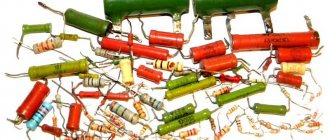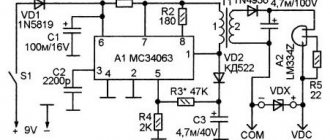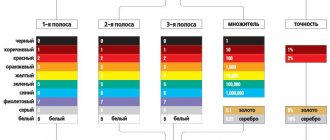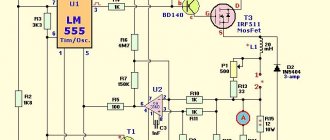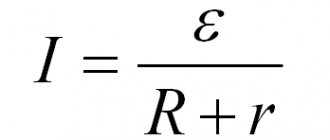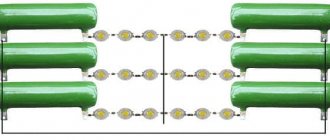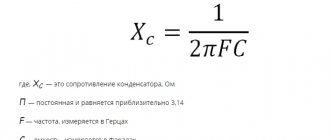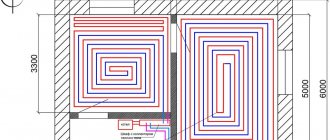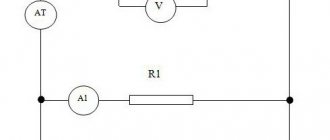Color marking of resistors is a set of colored rings on the element body, each of which corresponds to a specific digital code. The online resistor color coding calculator will allow you to quickly select the desired element for an electrical circuit that has a certain resistance value.
Resistor markings
As you already understood, resistors, being elementary components of electronics, provide current limitation and voltage reduction. This allows, for example, to work on LEDs with a supply voltage.
But ohmic resistances are inevitable not only in power supplies, but also in audio and video signal processing, as well as in digital technologies. In short, electrical resistance can be found in almost every electronic device. Therefore, it is not surprising that the devices themselves come in a variety of designs, and, regardless of the design, they must be appropriately labeled.
And so that the marking does not look like something complicated and incomprehensible to someone, they came up with a calculator to determine the resistance.
Universal color chart
There is a universal color table that allows you to quickly calculate the values of each resistor if necessary.
When creating such a table, the following fields are selected:
- The color of the ring or dot applied. In this case, both the name and an example are given.
- Depending on the value of the color, it is possible to convert the color coding into a numerical value. This is necessary when creating a diagram for symbolizing denominations.
- The multiplier allows for a mathematical calculation of what resistance the design in question has.
- Also , for almost every color there is a field that indicates the maximum deviation from the nominal value.
It is worth remembering that each color can indicate a number in the marking, a multiplier value, or a maximum deviation.
Examples
Example 1:
Let us consider the use of such a table using the following example: brown, black, red, silver. We read the rings from left to right, the resulting value is always encoded in Ohms.
According to the data from the table, we carry out the following decoding:
- The brown color in the first position represents both the digit and the multiplier. In this case, the number will be “1” and the multiplier “10”. It is worth noting that the following colors cannot be used in the first position: black, gold or white.
- The second color means the number of the second digit. Black means "0" and is not used in calculations. Having such data, we can conclude that the resistor has the alphanumeric marking 1K0.
- The third color determines the multiplier. In our case, it is red, the multiplier of this color is “100”.
- The last color means the maximum tolerance for deviation, and the silver color corresponds to 10%.
Using the table, we can say that the resistor in question is marked 1K0 and has a resistance value of 1000 Ohms (10*100) or 1 kOhm, as well as a tolerance of 10%.
Example 2:
Another more complex example is the calculation of the nominal values of the following resistor: red, blue, purple, green, brown, brown. This marking consists of 6 rings.
When decrypting, we note the following:
- 1 ring, red – number “2”.
- 2nd ring, blue – number “6”.
- 3rd ring, purple – number “7”.
- We select all numbers from the table. When they are combined, we get the number “267”.
- 4 ring is green. In this case, we pay attention not to the numerical value, but to the multiplier. Green color corresponds to a multiplier of 105. We carry out the calculation: 267 * 105 = 2.67 MOhm.
- 5 ring is brown and corresponds to a maximum deviation of 1% in both directions.
- Line 6 is brown , which corresponds to a temperature coefficient of 100 ppm/°C.
From the above example, we can say that deciphering the markings is not difficult, and the number of rings has virtually no effect on how complex the calculations will be. In this case, the resistor has a resistance of 2.67 MΩ with a deviation in both directions of 1% at a temperature coefficient of 100 ppm/°C.
The procedure can be simplified by using special calculators. However, not many people do the 6 ring calculation, which is worth considering.
The nominal series of resistors can be called the result of standardization of nominal values. Fixed resistors have 6 similar rows. Also, one row for variable denominations and a special row E3 have been introduced.
Using the example given denomination, let's decipher it:
- The letter “E” means that marking is carried out according to a series of denominations. This beech is always included in the designation.
- The numbers after the letter indicate the number of nominal resistance values in each decimal interval.
There are special tables displaying nominal series.
To identify standard series, GOST 2825-67 was adopted. At the same time, we can highlight several of the most popular standard series:
- Row E6 has a deviation in both directions of 20%.
- Row E 12 has a permissible deviation of 10%.
- The E24 series has a maximum permissible deviation in both directions of 5%.
The subsequent rows E48 and E96, E192 have a deviation rate of 2%, 1%, 0.5%, respectively.
Resistor color coding calculator
Of course, a unique device that is easily used and operated for determining and coding electrical resistance (what is it? (symbol R) in electrical engineering is a measure of an electrical quantity (U) that is necessary for a certain electric current (I) to flow through an electrical conductor; electrical resistance, for example, of a heating coil that heats up and evaporates the liquid, expressed in Ohms).
The calculator is designed so “easy” that it will allow you to find the resistance component in the shortest possible time.
Power dissipation
If electric current passes through a resistor, the electrical energy is converted into heat energy and the resistor heats up. Heat is dissipated into the environment. Moreover, thermal energy must be transferred to the environment so that the temperature of the resistor and its surrounding elements remains within normal limits. The power released by the resistor is determined by the formula:
Here V
is the voltage in volts across a resistor with resistance
R
in ohms,
I
is the current flowing through the resistor in amperes.
The power that a resistor can dissipate without degrading over a long period of time is called the maximum power dissipation
. In general, the larger the resistor body, the more power it can dissipate. Resistors of various powers are produced and you can find resistors from 0.01 W to hundreds of watts. Carbon resistors are usually available in 0.125–2 W ratings.
Color-coded 0.125, 0.25, 0.5 and 1 Watt resistors in a computer power supply
Why does the resistor calculator require a color code?
Although high power and bulk resistors can be labeled without any problems, the same cannot be said for small wire resistors.
Due to lack of “space” the numbers must be very small. In addition, when assembling printed circuit boards, you should always ensure that the resistor markings are legible. After all, you see, it will be very strange if you first need to remove a component in order to then be able to read its electrical value.
Largely because of this, color coding was introduced.
Foreign products
SMD resistor sizes
Despite the compliance of Russian and international standards noted above, the peculiarities of labeling of individual imported products should be taken into account. Panasonic, Philips and other well-known manufacturers set their own rules. Using additional color coding they indicate:
- features of production technology;
- recommended operating modes;
- resistance to certain adverse external influences.
Key concepts in the resistor calculator
Absolutely any color in the calculator is assigned a certain value, as is each definition, strictly speaking.
So, for the practical use of our device, you need to know about its “key definitions”, which will help you further understand the color code, that is, the markings.
- “Valence” and “multiplier” are quantities that help determine the actual resistance.
- “Tolerance” - this value indicates the amount by which the actual, that is, the resulting resistance can deviate from the normal one.
Briefly about the characteristics displayed in the markings
All types of resistors display the value and tolerance. Denomination is the main characteristic, but it’s impossible without approval. The tolerance is indicated as a percentage. It shows the magnitude of the possible deviation of the real value from the declared nominal value.
Sometimes the series or type is indicated
Even on old resistors, the series or type of resistor may be indicated. But this is on “Soviet” ones with alphanumeric markings. This is not available in the color version.
Table of connections between “color scheme” and key concepts
| Coloring on the resistor strip | Valence index | Factor | Tolerance index | Temperature coefficient value * |
| Colorless | does not exist | absent | range 20 percent | vague |
| Silver | does not exist | 10 to the power -2 | range 10 percent | vague |
| Golden | does not exist | 10 to the power -1 | 5 percent range | vague |
| Black | zero | unit | unknown | 200/1000000 |
| Brown | one | ten | range 1 percent | 100/1000000 |
| Red | two | one hundred | range 2 percent | 50/1000000 |
| Orange | three | 10 to the power of 3 | unknown | 15/1000000 |
| Yellow | four | 10 to the power of 4 | unknown | 25/1000000 |
| Green | five | 10 to the power of 5 | half percent range | vague |
| Blue | six | 10 to the power of 6 | range 0.25 percent | 10/1000000 |
| Purple | seven | 10 to the power of 7 | range 0.1 percent | 5/1000000 |
| Gray | eight | 10 to the power of 8 | range 0.05 percent | 1/1000000 |
| White | nine | 10 to the power of 9 | unknown | vague |
List of values for nominal series E6–E192
Modern powerful 10-watt ceramic resistor 8.6 Ohm and 2-watt resistor VZR 3.3 kOhm Soviet-made, manufactured in 1969.
E6 values
(20% tolerance):
1,0; 1,5; 2,2; 3,3; 4,7; 6,8.
E12 values
(10% tolerance):
1,0; 1,2; 1,5; 1,8; 2,2; 2,7; 3,3; 3,9; 4,7; 5,6; 6,8; 8,2.
E24 values
(tolerance 5%):
1,0; 1,1; 1,2; 1,3; 1,5; 1,6; 1,8; 2,0; 2,2; 2,4; 2,7; 3,0; 3,3; 3,6; 3,9; 4,3; 4,7; 5,1; 5,6; 6,2; 6,8; 7,5; 8,2; 9,1.
E48 values
(2% tolerance):
1,00; 1,05; 1,10; 1,15; 1,21; 1,27; 1,33; 1,40; 1,47; 1,54; 1,62; 1,69; 1,78; 1,87; 1,96; 2,05; 2,15; 2,26; 2,37; 2,49; 2,61; 2,74; 2,87; 3,01; 3,16; 3,32; 3,48; 3,65; 3,83; 4,02; 4,22; 4,42; 4,64; 4,87; 5,11; 5,36; 5,62; 5,90; 6,19; 6,49; 6,81; 7,15; 7,50; 7,87; 8,25; 8,66; 9,09; 9,53.
E96 values
(1% tolerance):
1,00; 1,02; 1,05; 1,07; 1,10; 1,13; 1,15; 1,18; 1,21; 1,24; 1,27; 1,30; 1,33; 1,37; 1,40; 1,43; 1,47; 1,50; 1,54; 1,58; 1,62; 1,65; 1,69; 1,74; 1,78; 1,82; 1,87; 1,91; 1,96; 2,00; 2,05; 2,10; 2,15; 2,21; 2,26; 2,32; 2,37; 2,43; 2,49; 2,55; 2,61; 2,67; 2,74; 2,80; 2,87; 2,94; 3,01; 3,09; 3,16; 3,24; 3,32; 3,40; 3,48; 3,57; 3,65; 3,74; 3,83; 3,92; 4,02; 4,12; 4,22; 4,32; 4,42; 4,53; 4,64; 4,75; 4,87; 4,99; 5,11; 5,23; 5,36; 5,49; 5,62; 5,76; 5,90; 6,04; 6,19; 6,34; 6,49; 6,65; 6,81; 6,98; 7,15; 7,32; 7,50; 7,68; 7,87; 8,06; 8,25; 8,45; 8,66; 8,87; 9,09; 9,31; 9,53; 9,76.
E192 values
(tolerance 0.5% or more precisely):
1,00; 1,01; 1,02; 1,04; 1,05; 1,06; 1,07; 1,09; 1,10; 1,11; 1,13; 1,14; 1,15; 1,17; 1,18; 1,20; 1,21; 1,23; 1,24; 1,26; 1,27; 1,29; 1,30; 1,32; 1,33; 1,35; 1,37; 1,38; 1,40; 1,42; 1,43; 1,45; 1,47; 1,49; 1,50; 1,52; 1,54; 1,56; 1,58; 1,60; 1,62; 1,64; 1,65; 1,67; 1,69; 1,72; 1,74; 1,76; 1,78; 1,80; 1,82; 1,84; 1,87; 1,89; 1,91; 1,93; 1,96; 1,98; 2,00; 2,03; 2,05; 2,08; 2,10; 2,13; 2,15; 2,18; 2,21; 2,23; 2,26; 2,29; 2,32; 2,34; 2,37; 2,40; 2,43; 2,46; 2,49; 2,52; 2,55; 2,58; 2,61; 2,64; 2,67; 2,71; 2,74; 2,77; 2,80; 2,84; 2,87; 2,91; 2,94; 2,98; 3,01; 3,05; 3,09; 3,12; 3,16; 3,20; 3,24; 3,28; 3,32; 3,36; 3,40; 3,44; 3,48; 3,52; 3,57; 3,61; 3,65; 3,70; 3,74; 3,79; 3,83; 3,88; 3,92; 3,97; 4,02; 4,07; 4,12; 4,17; 4,22; 4,27; 4,32; 4,37; 4,42; 4,48; 4,53; 4,59; 4,64; 4,70; 4,75; 4,81; 4,87; 4,93; 4,99; 5,05; 5,11; 5,17; 5,23; 5,30; 5,36; 5,42; 5,49; 5,56; 5,62; 5,69; 5,76; 5,83; 5,90; 5,97; 6,04; 6,12; 6,19; 6,26; 6,34; 6,42; 6,49; 6,57; 6,65; 6,73; 6,81; 6,90; 6,98; 7,06; 7,15; 7,23; 7,32; 7,41; 7,50; 7,59; 7,68; 7,77; 7,87; 7,96; 8,06; 8,16; 8,25; 8,35; 8,45; 8,56; 8,66; 8,76; 8,87; 8,98; 9,09; 9,20; 9,31; 9,42; 9,53; 9,65; 9,76; 9,88.
Color coding of resistors
How to use an online resistor calculator?
In fact, it is quite easy to use. Simply following the next two steps will allow you to make the calculation.
Step 1: First we count how many color stripes on the resistor we want to calculate. This number gives us the resistor band number. Since devices with 4 bands are most common, the calculator immediately displays a window for calculating the resistance with its data. But in the case when the range number of our resistor is five or six, we change the range number in the range selection section.
Action 2. Once we select the desired value of the stripes, all we have to do is click on the color we want, which we see on the resistor (from the drop-down menus under the resistor symbol in the correct order).
Introduction
A resistor is an electronic device that has a certain resistance. Its main task is to convert current into voltage and vice versa. Due to its small size, it is not always possible to apply and read markings from a resistor - for example , a 0.25-watt device, quite often used in systems engineering, has a length of no more than 3.2 mm with a diameter of 1.8 mm . That is why the color marking scheme was developed. It is international, it was approved by IEC (International Electrotechnical Commission) and the requirements of GOST 175-72.
Marking resistors with stripes
Stripes should be read from left to right. The first ring is applied closer to the wire exit from the device.
4-5-6 band resistors
4-way resistors
4-way resistors are the group of devices you are most likely to encounter, as they are the most common on the “market”.
1, 2 and 3 show the resistance value, but the rest show the throughput of the device. The lines showing the resistance value are usually located close to each other. For some, the thickness of the fourth stripe is slightly different from the others.
For the three bars showing R data, shade options are shown below.
For black coloring the valence value corresponds to zero; for brown - units. But then we go further - in ascending order, from 2 to 9: red tint, orange, yellow, green, blue, purple, gray, white.
Each color has its own number attached.
R 150 Ohm
For example, the 2 initial stripes for the above value correspond to brown and green. Since brown represents the number 1 and green represents the number 5, adding these numbers together gives the number 15.
Resistor 4.7 kOhm
For the above resistor, the first shade is yellow and the second is purple. When we look at the table, we see that yellow is 4 and purple is 7. When we combine these two numbers, we get 47.
The third color gives us the resistance multiplier. We will use the numbers given in the table above when finding the multiplier. For a multiplier, the number corresponding to a color is written as its exponent of 10. For example, 10 to the 2nd power is equal to 100 - this is the value of our multiplier, since red is equivalent to two. In addition to the colors shown in the table above for the multiplier, there are two more options for small resistor values. For gold and silver, our multiplier is less than 1. You can see the multiplier values for all color tones in the table below.
| Colors | Factor |
| Black | unit |
| Brown | ten |
| Red | one hundred |
| Orange | one thousand |
| Yellow | ten thousand |
| Green | one hundred thousand |
| Blue | one million |
| Purple | ten millions |
| Gray | hundred million |
| White | one billion |
| Golden | ten to the power -1 |
| Silver | ten to the power -2 |
To calculate the resistor reading, we need to multiply the two-digit number, which is known thanks to the coloring of the initial 2 stripes, by the value of the multiplier.
R 150 Ohm
For example, for a resistor with a value of 150 Ohms, the number 15 is what we recognize thanks to the coloring of the initial 2 stripes. Since the third stripe is brown, our multiplier is 10. When we multiply these two numbers, we get 15x10=150. Therefore, the resistor value is 150 ohms.
Resistor 4.7 kOhm
For the resistor above, we got 47 from the first two numbers. Since the third bar is red, our multiplier value is 100. Since 47 times 100 equals 4700, we know the final result will be 4.7 kOhms.
It is worth saying a very important thing - it happens that resistors produced repeatedly at the same or the same plant differ from each other in physical and chemical quantities.
The coloring of the extreme line shows the maximum proportional difference between the number we calculated and the actual value. Thus, the fourth bar demonstrates how the true reading can deviate from the calculated one. The amount of deviation that occurs is expressed as a percentage. For example, a device (one hundred ohms with a five percent offset) could have any value in the range of ninety-five ohms to one hundred and five ohms.
Below we see what tolerance (tolerance) corresponds to a 4-way device.
| Colors | Tolerance |
| Golden | five percent |
| Silver | ten percent |
| Dark red | about one and a half percent |
| Burgundy | 2.5 percent |
| Dark green | half a percent |
| Blue | quarter of a percent |
| Blue | one tenth of one percent |
| Dark brown | five hundredths percent |
.
5-band resistors
The name speaks for itself - they have as many as five multi-colored stripes.
The color calculation of these devices is very similar to four-band ones.
The only difference between these electrical appliances is the following: instead of a two-digit number from the first two colors, we get a three-digit number from the initial stripes (3-x). Let's say we have the following coloring on the first, 2nd and 3rd lines: burgundy color - 1st line, 2nd and 3rd - black shades. In the end, we will get the number 200, because if the first strip is the number 2, then the next stripes correspond to zero. The fourth stripe shows in this case the magnitude of the multiplier for these resistors. Here we again use the multipliers from the table above.
If we multiply the value of the number that we obtained while studying the color of the resistor by a factor, then we get the necessary answer and find the value of the resistor.
For example, when the colors of the first four stripes respectively look like this: 1) brown; 2) green; 3) black; 4) orange, then we can immediately find the numbers 150 and 1000. When we multiply these two numbers, we see that the resistance value will be numerically equal to one hundred and fifty thousand ohms.
6-band resistors
The valency and resistance calculation of six-band resistors is exactly the same as that of three-band resistors. For a six-band device, we take the three-digit number from the 3 initial strips and multiply it by the factor indicated by the fourth strip. This gives us the resistance value. The color characteristic in the fifth band allows us to find the required tolerance.
In six-band resistors, the outer band also gives data on the sensitivity of the device in relation to temperature, unlike the others. For example, a 100 ohm resistor at 25°C can become 98 ohms when heated to 80°C. The sixth bar shows the change in resistance when the temperature changes by 1 ℃.
We use the following color scheme for the 6th range.
| Hue | Temperature sensitivity (ppm/℃) |
| Black | 250ppm/℃ |
| Brown | 100ppm/℃ |
| Red | 50ppm/℃ |
| Orange | 15ppm/℃ |
| Yellow | 25ppm/℃ |
| Green | 20ppm/℃ |
| Blue | 10ppm/℃ |
| Violet | 5ppm/℃ |
| Grey | 1ppm/℃ |
We see that the resistances that change the most at 250 ppm/℃ are black in the last band and change the least at 1 ppm gray.
What is it for?
Low power resistors are very small in size, their power is about 0.125 W.
The diametric size of this version is about a millimeter, and the length is several millimeters. Reading the parameters, which often have several numbers, is quite difficult, as is plotting them. When indicating the denomination, if the dimensions allow, a letter is often used to determine the fractional value of the value.
An example is 4K7, which means 4.7 kOhm. However, this method is also not applicable in some cases.
The color scheme of the marking has the following features:
- Easy to read.
- Easier to apply.
- Can convey all the necessary information about denominations.
- Over time, information is not erased.
At the same time, we can note the main difference in this marking:
- At 20% accuracy , a marking containing 3 stripes is used.
- If the accuracy is 10% or 5% , then 4 stripes are applied.
- More precise versions have 5 or 6 stripes.
To summarize, we can say that applying colors allows you to find out the accuracy and nominal values of the resistor, for which you need to use special tables or online services.
How to check yourself
If you are not yet confident in deciphering codes, there are two ways to check the resistance of the resistor. The first is software, the second is using a multimeter. The second one is more reliable, since you see the real state of things, and at the same time check the resistance of the element.
One of the programs for deciphering resistor codes “Resistor 2.2”: color coding
It’s easy to find a program for deciphering resistor codes—more than a dozen pop up upon request. They are simple, differing only in the scale of the databases. Not all code options can be found in every one, but popular ones are available everywhere. In these programs, you first select the type of encoding (letters or stripes), and then enter all the data. What you enter is displayed in a special window so that you can visually check the correctness of the entered information. After entering the data, press the button, the program gives you the denomination and tolerance. Compare with what you got.
Checking the resistance with a multimeter
You can also check how correctly you determined the resistance of the resistor by coding using a multimeter. To do this, set it to the “change resistance” mode. We select the range depending on what we counted. We apply one probe to one terminal, the second to the other. The resistance is displayed on the screen. It may differ from the calculated one. The difference depends on the tolerance. The larger the tolerance, the greater the difference can be. But in any case, the readings should be comparable to the found denomination. See the video for details.

